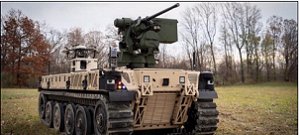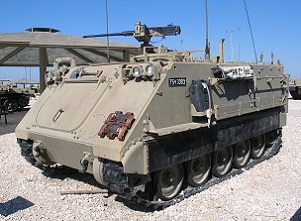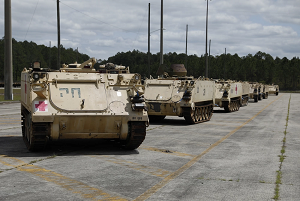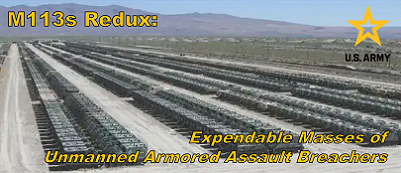[Editor’s Note: In 2018, our pacing challenge China experimented with converting obsolete Type 59 Main Battle Tanks (MBTs) into Unmanned Ground Vehicles (UGVs), teleoperated from afar to protect crewmembers from hazardous missions deemed too risky for crewed combat vehicles. During its on-going “Special Military Operation” in Ukraine, Russia employed unmanned T-54/55 MBTs and MTLB armored artillery tractors as Vehicle-Borne Improvised Explosive Devices (VBIEDs) in field-expedient efforts to breach Ukrainian defenses.

As of August 2023, the Assistant Secretary of the Army for Acquisitions, Logistics, and Technology (ASA[ALT]) announced that the United States Army’s Robotic Combat Vehicle (RCV) Program would focus its efforts on developing the RCV-Light (RCV-L), an expendable unmanned weapon system armed with limited self-defense systems, anti-tank guided missiles (ATGMs), or recoilless weapons. Designed to serve as “scouts” and “escorts” for manned fighting vehicles to deter ambushes and guard the flanks of mechanized formations, these RCVs are initially intended to be controlled by operators riding in Next Generation Combat Vehicles (NGCVs), and ultimately operated in a more autonomous role with the advent of improved ground navigation technology and artificial intelligence (AI). A Request for Prototype Proposal (RPP) has been issued that could select up to four defense industry vendors to deliver test vehicles by August 2024.
But what about now — how could today’s fielded force rapidly benefit from today’s increasingly automated battlespace, characterized by rapid tactical innovation?
In today’s post, Army Mad Scientist welcomes guest blogger Jason Flores Rutledge with his modest proposal to leverage the U.S. Army’s inventory of hoary M113 Armored Personnel Carriers (APCs) as remotely-operated assault vehicles. In repurposing these lightly armored Cold War relics into unmanned, remotely-operated breach vehicles, Mr. Rutledge proposes to overwhelm adversarial defensive positions with expendable masses of tracked armor, opening breaches for subsequent exploitation by penetrating forces. Should the Army transform these obsolete systems into “low hanging fruit” force multipliers or continue sequestering them away in deep storage — or worse — dump them off-shore to create artificial reefs? You decide — Read on!]
This essay argues that the Army should begin transforming obsolete vehicles into expendable vehicle formations meant to breach the enemy’s strongest positions. The argument uses the premise of turning today’s severely outdated M113 Armored Personnel Carriers (APCs) into remotely-operated machines, then forming them into Remotely-Operated Breach Brigades (ROBBs).
The feasibility of implementing the ROBB concept has already transcended from the theoretical to the practical. As presented by Todd South and Dan Parsons in separate articles, M113s are being used as testbeds and stand-ins for evaluating a variety of concepts for later designs.1, 2 First, the vehicles have been fitted with special controls and have shown that they can be remotely operated, proving the ability to control such machines at a distance. Second, the APCs have already been tested as hosts of numerous weapon systems, with the aim of showing such devices can be remotely controlled. And third, the Army already has experimented with modified M113s in small formations and plans to test various concepts at the company-level. The Army is testing the viability of having newer remotely-operated designs work with manned vehicles. However, all of this is meant to inform new systems designs rather than employ M113s in the future. This is a mistake.
As Dan Parsons observed, these facts prove that all M113s can be readily turned into remotely-operated fighting platforms. To reiterate, repurposing large numbers of M113s into remotely-controlled vehicles for future use isn’t new; employing large formations of them to breach formidable defenses is.
The question is — why use old machines when newer systems could be more effective?

There are incredible cost benefits associated with re-purposing M113s as remotely-operated platforms. There are few new development costs associated with these proven platforms. Additionally, sustainment costs could be reduced (especially CLASS IX), as the plethora of platforms produced over the past 60-plus years could be cannibalized to sustain those fielded in ROBBs. The Army would employ these remote controlled M113s until attrited. As the Army runs out of M113s, subsequent generations of Armored Fighting Vehicles (AFVs) could be automated as they approach obsolescence (e.g., first generation M2 Bradley Infantry Fighting Vehicles).
 In fact, there’s such disregard for M113s that hundreds of them were dumped into the ocean to create artificial reefs.3 Why build an expensive new platform when masses of obsolete vehicles can be employed to achieve the same objective?
In fact, there’s such disregard for M113s that hundreds of them were dumped into the ocean to create artificial reefs.3 Why build an expensive new platform when masses of obsolete vehicles can be employed to achieve the same objective?
In the vein of Multi-Domain Operations, a ROBB adds to the enemy’s list of dilemmas. Positions once considered unassailable or too costly to take in terms of lives lost and public support undermined, now become viable targets — forcing enemy commanders to reinforce these positions or accept risk and maintain a broader defense.
As noted by South, remotely-operated machines’ ranges are currently limited to approximately two kilometers from their controllers. This could be overcome by establishing a “chain” of communication nodes as the brigade maneuvers. M113s equipped with relays could be employed as bounding relay nodes. Loitering stealth drones could also provide the requisite connectivity, extending the remote-controlled M113’s operational range even further.
In conclusion, this paper advocates for the formation of ROBB formations as a temporary solution for potential wars in the near term. Obsolete M113s can be repurposed to deliver massed unmanned assaults to reduce the enemy’s strongest defenses. Turning obsolete vehicles into remotely-operated machines can save money and lives. ROBB formations could become a permanent feature of Army operations as future generations of Armored Combat Vehicles become obsolescent and are repurposed as unmanned assault vehicles.
If you enjoyed this post, check out Army Mad Scientist’s Insights from the Robotics and Autonomy Series of Virtual Events, all of the associated webinar content (presenter biographies, slide decks, and notes), and watch the associated videos
… and review the following related content:
Unmanned Capabilities in Today’s Battlespace
Insights from the Robotics and Autonomy Series of Virtual Events, as well as all of the associated webinar content (presenter biographies, slide decks, and notes) and associated videos
Jomini’s Revenge: Mass Strikes Back! by proclaimed Mad Scientist Zachery Tyson Brown
Major Trends in Russian Military Unmanned Systems Development for the Next Decade, Russian Ground Battlefield Robots: A Candid Evaluation and Ways Forward, and Autonomous Robotic Systems in the Russian Ground Forces, by proclaimed Mad Scientist Sam Bendett
Insights from Ukraine on the Operational Environment and the Changing Character of Warfare
Top Attack: Lessons Learned from the Second Nagorno-Karabakh War and its associated podcast, as well as Sooner Than We Think: Command Post Survivability and Future Threats and its associated podcast, both with COL John Antal (USA-Ret.)
Insights from the Nagorno-Karabakh Conflict in 2020 (Part I and II)
“Once More unto The Breach Dear Friends”: From English Longbows to Azerbaijani Drones, Army Modernization STILL Means More than Materiel, by Ian Sullivan.
Through Soldiers’ Eyes: The Future of Ground Combat and its associated podcast
The Future of Ground Warfare and its associated podcast, with proclaimed Mad Scientist COL Scott Shaw
Ground Warfare in 2050: How It Might Look, The Intelligent Battlefield of the Future, and its associated podcast with proclaimed Mad Scientist Dr. Alexander Kott
“Own the Night” and the associated Modern War Institute podcast with proclaimed Mad Scientist Mr. Bob Work
About the Author: Jason Flores Rutledge is a civilian friend of the Army. He has unfortunately been disabled, but seeks to contribute to society through his writings. He also hopes to eventually earn an honorary rank over time. Jason’s unusual achievements include high placements in wargames, both online and at hobby stores. Presently, he is working on more topics related Multi-Domain Operations.
Disclaimer: The views expressed in this blog post do not necessarily reflect those of the U.S. Department of Defense, Department of the Army, Army Futures Command (AFC), or Training and Doctrine Command (TRADOC).
Endnotes
1 South, Todd. “Army’s 4th ID runs robot wingmen on scouting maneuvers,” Army Times, 10 Oct. 2020, https://www.armytimes.com/news/your-army/2020/08/10/armys-4th-id-runs-robot-wingmen-on-scouting-maneuvers/. Accessed 25 Oct. 2023.
2 Parsons, Dan. “Army Tests Uncrewed M113 Armed with Laser-Guided Rocket Launcher,” The Drive, 20 May. 2022, https://www.thedrive.com/the-war-zone/army-tests-uncrewed-m113-armed-with-laser-guided-rocket-launcher. Accessed 25 Oct. 2023.
3Tan, Michelle. “Soldiers create offshore reef using old armored vehicles,” Army Times, 26 Oct. 2014, https://www.armytimes.com/news/your-army/2014/09/20/soldiers-create-offshore-reef-using-old-armored-vehicles/. Accessed 26 Oct. 2023.



